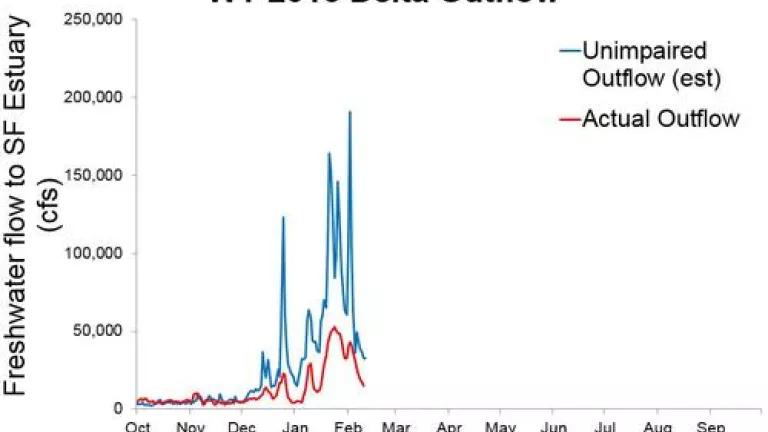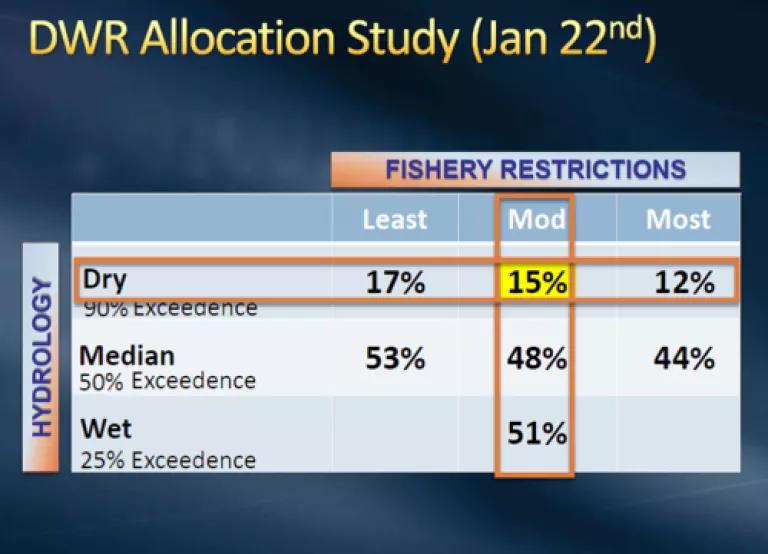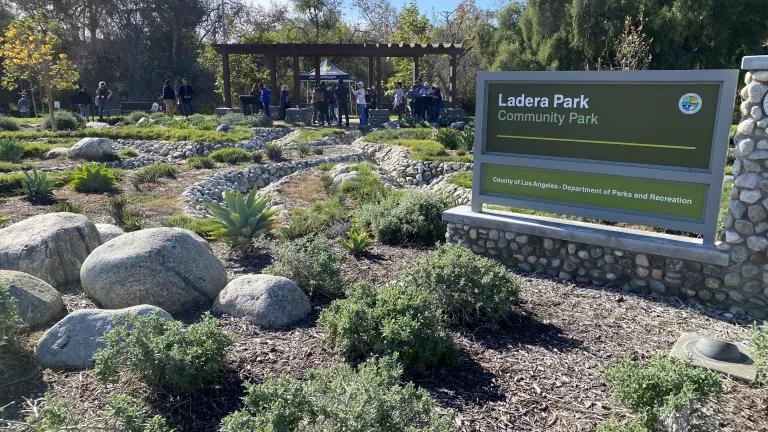
Recently, some legislators have been demanding that state and federal agencies - or Congress - overrule the decisions of agency biologists and scientists in order to increase the amount of water pumped out of the Delta, complaining that the state and federal water projects are not capturing most of the water from recent storms. Yet recent analysis by The Bay Institute shows that approximately 66% of the runoff in January 2016 was captured or diverted, with only one third of the unimpaired runoff actually making it through the Bay-Delta estuary. For the period of October 1st to January 31st, 60% of the storm runoff has been diverted or stored. Compare this level of diversions to the prevailing science, which shows that, to maintain a healthy river system, no more than 20% of its flows, on average, should be diverted.
Source: The Bay Institute 2016
As the graph above shows, California already is capturing most of the runoff that naturally would have flowed down the Sacramento and San Joaquin Rivers, through the Delta and into San Francisco Bay. Where did this water go? In the month of January alone, more than 3 million acre feet of water was stored in upstream reservoirs (California has nearly 1,400 dams and reservoirs across the State), and in addition to reservoir storage, the CVP and SWP exported over 281,000 acre feet of water from the Delta in the month of January. According to data from the Department of Water Resources, Shasta Dam alone increased storage by nearly 1 million acre feet in the month of January, and storage in Shasta and other reservoirs continue to increase.
|
Reservoir |
Storage Increase in January 2016 |
|
Shasta Reservoir |
947,685 acre feet |
|
Oroville Reservoir |
540,830 acre feet |
|
Folsom Reservoir |
304,676 acre feet |
|
New Bullards Bar Reservoir (Yuba River) |
196,758 acre feet |
|
New Melones Reservoir (Stanislaus River) |
84,918 acre feet |
|
Don Pedro Reservoir (Tuolumne River) |
116,213 acre feet
|
|
Total for these 6 reservoirs |
2,191,080 acre feet |
That stored water will be released from reservoirs later in the year to provide water deliveries to cities and farms, including agribusinesses that contract with the Central Valley Project and State Water Project and the Metropolitan Water District of Southern California (MWD). According to MWD (see graphic below), even with scientifically justified restrictions on pumping in the Delta like those implemented in January and February, if 2016 turns out to have average levels of rain and snow, the State Water Project will likely deliver 40-50% of maximum contract amounts to the cities in the MWD service area and to agribusinesses within the Kern County Water Agency in the San Joaquin Valley. If it remains dry, the State Water Project allocation will remain low.
But as the graphic from Metropolitan below demonstrates, hydrology - not pumping restrictions - is the primary driver of water supply allocations. And if the State Water Project delivers a 50% allocation, MWD staff informed their Board of Directors earlier this week that MWD anticipates putting more than 300,000 acre feet of water into storage for future dry years.

The good news is that the snowpack in the Sierra Nevada Mountains is better than the past several years, and the amount of water stored in upstream reservoirs is generally ahead of last year's levels. The bad news is that storage in most of the State's reservoirs is still far below average levels for this time of year, and after a hot and dry period in February the state's snowpack is now below average for this time of year - and significantly below average for the water year. In other words, if 2016 remains dry and warm, things are looking rough for farmers, fishermen, cities and our beleaguered fish and wildlife.
But the notion that California isn't diverting enough water from the Bay-Delta watershed is simply false - we're already diverting or storing more than half of the water that would naturally flow through the watershed.
The best available science shows that current restrictions in the Bay-Delta are inadequate to protect salmon and other endangered fish and wildlife, and the thousands of jobs that depend on them. The existing biological opinions undergo independent scientific review every year, and scientific information developed since they were promulgated demonstrates that if anything, the biological opinions need to be stronger.
And the idea that the State and Feds should overrule their biologists and make decisions based on political science, not biological science, is not only ludicrous, it is dangerously short-sighted. As I wrote recently in the LA Times, the decisions we make during droughts last for decades, and waiving the rules now to pump a little more water not only hurts fish and wildlife and the jobs and communities that depend on them, but will impact water supply for years, if not decades, to come.



